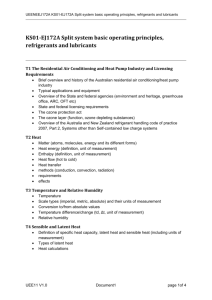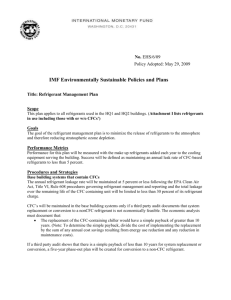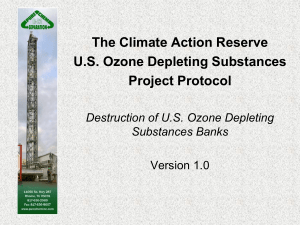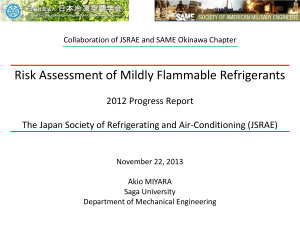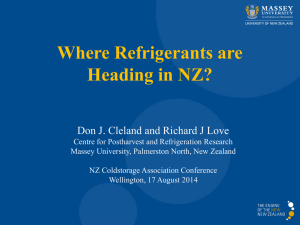VC39 Notes on Refrigerants (Word 76KB)
advertisement
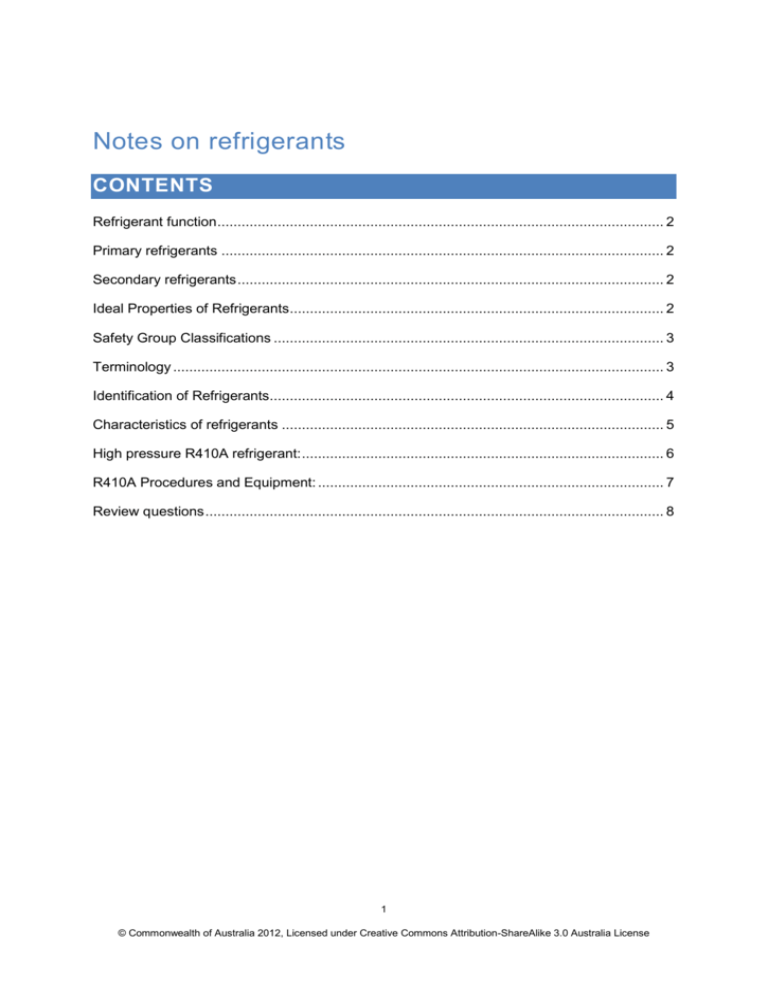
Notes on refrigerants CONTENTS Refrigerant function ............................................................................................................... 2 Primary refrigerants .............................................................................................................. 2 Secondary refrigerants .......................................................................................................... 2 Ideal Properties of Refrigerants ............................................................................................. 2 Safety Group Classifications ................................................................................................. 3 Terminology .......................................................................................................................... 3 Identification of Refrigerants.................................................................................................. 4 Characteristics of refrigerants ............................................................................................... 5 High pressure R410A refrigerant: .......................................................................................... 6 R410A Procedures and Equipment: ...................................................................................... 7 Review questions .................................................................................................................. 8 1 © Commonwealth of Australia 2012, Licensed under Creative Commons Attribution-ShareAlike 3.0 Australia License REFRIGERANT FUNCTION A refrigerant is a substance used in refrigeration systems to absorb heat in the evaporator, by changing state from a liquid to a vapour and rejects this heat in the condenser as it changes back to a liquid. Refrigerants can be classed as primary or secondary refrigerants. PRIMARY REFRIGERANTS Primary refrigerants are substances that change twice (once in the evaporator and once in the condenser) and produce refrigeration (cooling) by vaporisation. Primary refrigerants transfer the bulk of the heat through a latent heat process. SECONDARY REFRIGERANTS Secondary refrigerants absorb heat and change temperature in order to transfer heat from the substance or product to be cooled. They usually do not change state in the cooling cycle but change temperature by absorbing sensible heat. A good example of a secondary refrigerant is chilled water. IDEAL PROPERTIES OF REFRIGERANTS high latent heat to produce large refrigerating effect in the cycle of operation low boiling point at atmosphere pressure so as to be able to produce low temperatures low condensing temperature at relatively low head pressure high critical temperature low specific volume of vapour per kilowatt of refrigeration no corrosive action on metals used a chemical compound that will be stable under all working conditions non flammable and non explosive no odour and non poisonous easy to detect leaks in the system no affinity to moisture, so that no gases or acids will be formed affecting system operation no reaction with lubricants used. 2 © Commonwealth of Australia 2012, Licensed under Creative Commons Attribution-ShareAlike 3.0 Australia License SAFETY GROUP CLASSIFICATIONS A = Low toxicity. B = High toxicity. 1 = Low flammability. 2 = Medium flammability. 3 = High flammability. Group A1 refrigerants are the least hazardous, group B3 the most hazardous. Group A1 – common refrigerants: R11, R12, R22, R134a, R500. Group B1 – common refrigerants: R123, R764. Group B2 – common refrigerants: R40, R611, R717. TERMINOLOGY Azeotrope – consists of a mixture of two (2) or more chemical compounds. They form a new refrigerant with its own properties, do not separate and have a constant saturation temperature. Charging can be either as a liquid or as a vapour. Temperature glide – occurs when the evaporating (or condensing) temperature changes during the vaporisation (boiling or condensation) process, due to the composition changes that occur in blend refrigerants. Temperature glide should be checked when choosing a replacement refrigerant. Zeotropic (Blends) – is a new refrigerant made from two (2) or more different refrigerants (blends). They are a mixture of volatile substances, which change in composition as they evaporate. Evaporating temperature changes (Glide) as the more volatile component distils out of the less volatile components. MUST be liquid charged. Examples include the R400 family. 3 © Commonwealth of Australia 2012, Licensed under Creative Commons Attribution-ShareAlike 3.0 Australia License IDENTIFICATION OF REFRIGERANTS Refrigerants are identified by: trade name or number chemical name or formula ANSI / ASHRAE standards AS 4484 colour code. 4 © Commonwealth of Australia 2012, Licensed under Creative Commons Attribution-ShareAlike 3.0 Australia License CHARACTERISTICS OF REFRIGERANTS Condensing and boiling temperatures These determine the range of selection and eliminate a large number of the possible liquids. The boiling point for the temperature required may be too high to produce the low temperature desired, or it may require a very low pressure (high vacuum) to produce the low temperature. A high boiling point on the suction side requires a vacuum for operating at low temperatures. A very low boiling point usually requires a very high head pressure to produce condensation. Latent heat value of refrigerant Latent heat should be high for the change of state at the boiling point. The higher the latent heat, the less refrigerant required to be circulated per kilowatt of refrigeration. Type/temperature of condensing medium Mediums used frequently are water and air. Displacement volume of the compressor The size of the compressor needed can dictate the choice of refrigerant to be used. Some refrigerants require large compressor capacity because the refrigerants they compress are received at very low pressures. Density of the vapour should be high. The refrigerant used should not require a pressure below atmospheric pressure to produce the refrigerating temperature. Toxicity or poisonous action Refrigerants may pose a health hazard from lethal poisoning (chemical substance being taken into the blood stream) or from suffocation (refrigerants are generally heavier than air and precautions should be taken in confined spaces). Flammability and explosiveness These factors carry considerable weight in the selection of refrigerant from the standpoint of the fire risk. Most volatile gases containing hydrogen are flammable and some become highly explosive when broken down or subject to temperatures above 38 °C in the presence of carbon compounds. These refrigerants often have environmental advantages over the ‘safer’ refrigerants and with correct training and compliance with safety standards, they can be 5 © Commonwealth of Australia 2012, Licensed under Creative Commons Attribution-ShareAlike 3.0 Australia License used successfully. Odour Odour might be desirable in finding leaks in a system, but if the odour has a bad effect on an individual, then it becomes a disadvantage. Some toxic refrigerants are odourless and in these cases material having a strong odour such as ammonia is introduced into the refrigerant to inform operators that a leak has occurred. Stability of gas Stability of gas is very desirable. A refrigerant should not decompose at any temperature that may be encountered in the system – otherwise losses and possibly serious operating effects may result. Corrosive action on metals The effect of refrigerants on structural metals of the system is important as ammonia, for example, cannot be used with copper or copper alloys. However, copper can be used with fluorocarbon refrigerants. Effect on lubricating oil The refrigerant must not form destructive compounds, destroy lubricating properties, nor solidify or congeal at low temperatures with oil. Critical temperature The temperature above which a gas cannot be condensed into a liquid by increasing the pressure. The temperature at which the liquid flashes into a vapour without the addition of latent heat. The highest temperature to which the liquid can be raised under any pressure and still remain a liquid. Non-hazardous This assumes that the refrigerant is non toxic, non irritating, non flammable, non explosive, not hazardous to stored food or other products and will not cause a fire hazard if a large leak occurs. Environmental properties A refrigerant should have a zero or low Ozone Depletion Potential (ODP), a low Global Warming Potential (GWP) and a short atmospheric life. HIGH PRESSURE R410A REFRIGERANT: 6 © Commonwealth of Australia 2012, Licensed under Creative Commons Attribution-ShareAlike 3.0 Australia License R410A is a zero ozone-depleting (ODP) refrigerant, as it doesn’t contain chlorine to damage the ozone layer. Its pressures are approximately 60% higher (1.6 times) than R22. R410A is a zeotropic refrigerant and is made up of R32 (50%) and R125 (50%). R410A PROCEDURES AND EQUIPMENT: R410A is only used in units designed for R410A use and is not to be used for retrofitting existing systems. Due to higher pressures R410A requires dedicated specialised cylinders, gauges, lines and recovery equipment. R410A uses synthetic POE oil, as do all HFC refrigerants, and is hygroscopic (absorbs moisture). Being a zeotropic refrigerant R410A has differential leakage rates and must be liquid charged. Follow manufacture’s installation instructions when using R410A and ensure compliance with Australian acts, regulations and codes. Only authorised technicians are to install or service systems designed for R410A. 7 © Commonwealth of Australia 2012, Licensed under Creative Commons Attribution-ShareAlike 3.0 Australia License REVIEW QUESTIONS 1. What is the function of a refrigerant substance? See page 2. 2. What do primary refrigerants do? See page 2. 3. What do secondary refrigerants do? See page 2. 4. What are the characteristics of refrigerants I need to remember? See pages 3 and 4. 5. What are the ideal properties of refrigerants? See page 5. 6. What are the four (4) ways I can identify refrigerants? See page 6. 7. What are four (4) safety group classifications? See page 7. 8. What do these words mean? See page 8 a. azeotrope b. zeotropic blends c. temperature glide. 9. List three (3) important points about R410A refrigerant. See page 8. 10. List six (6) important points about R410A procedures and equipment. See page 8. 8 © Commonwealth of Australia 2012, Licensed under Creative Commons Attribution-ShareAlike 3.0 Australia License

